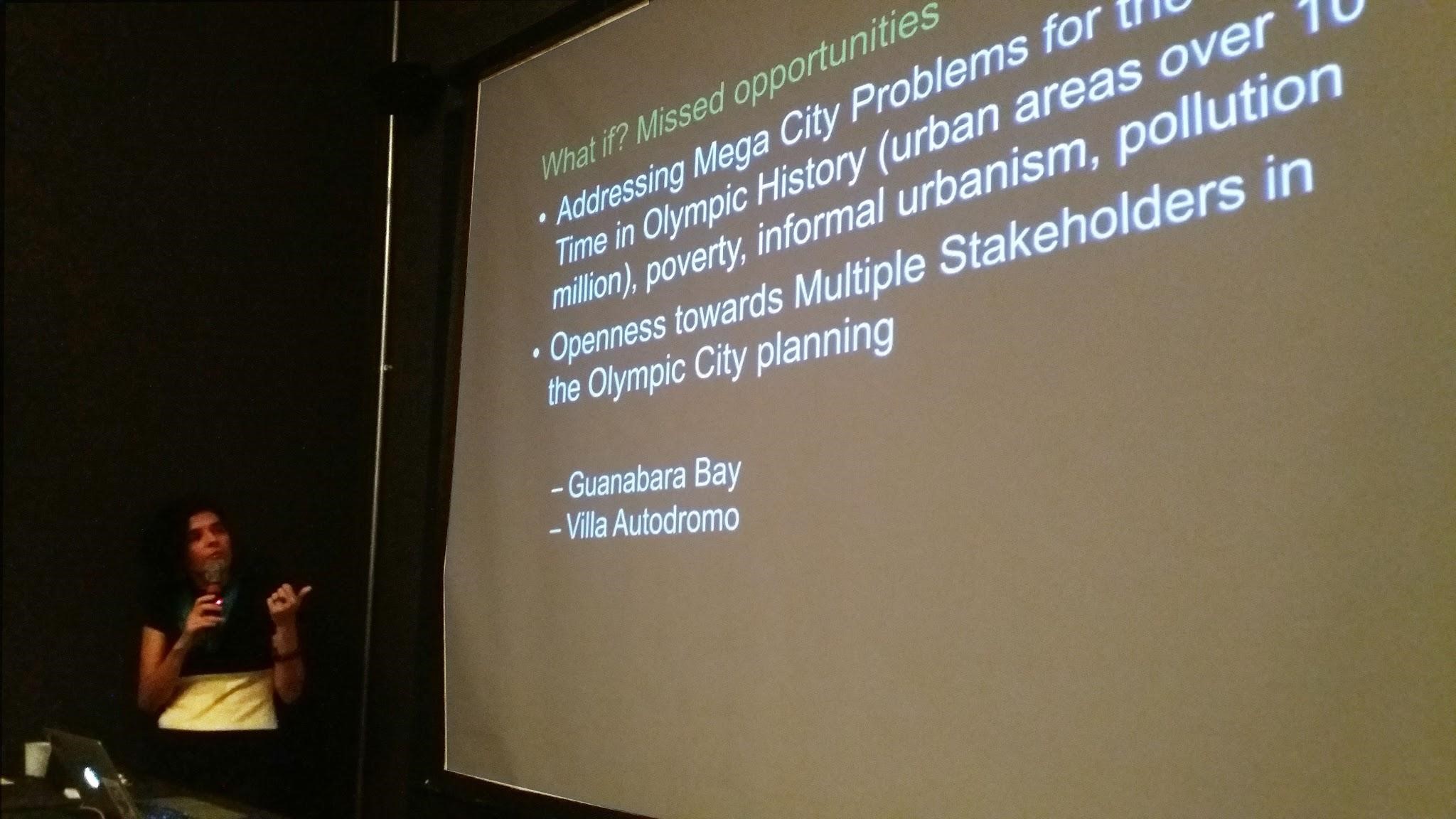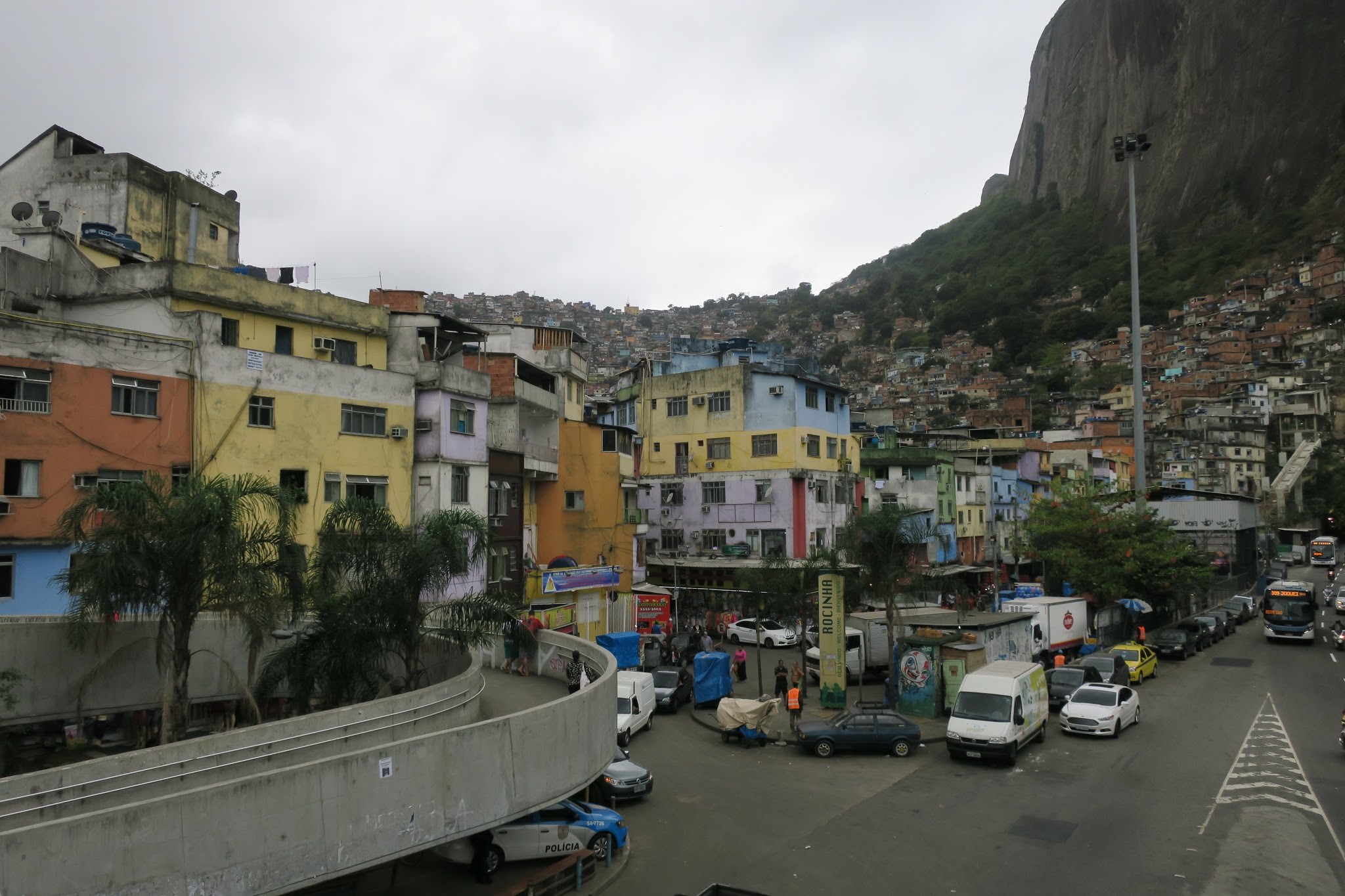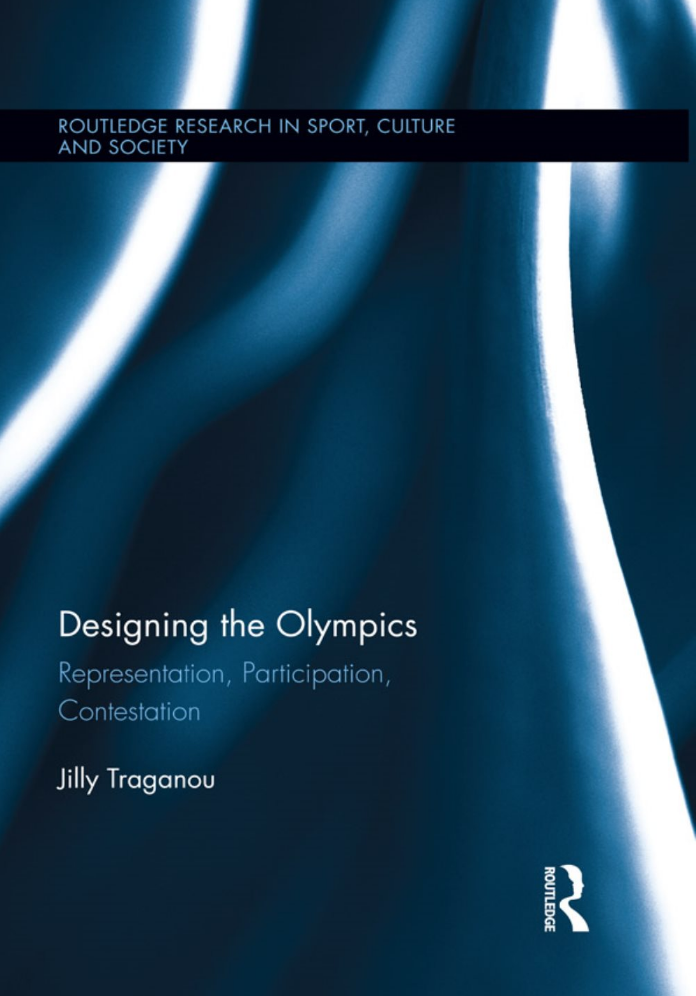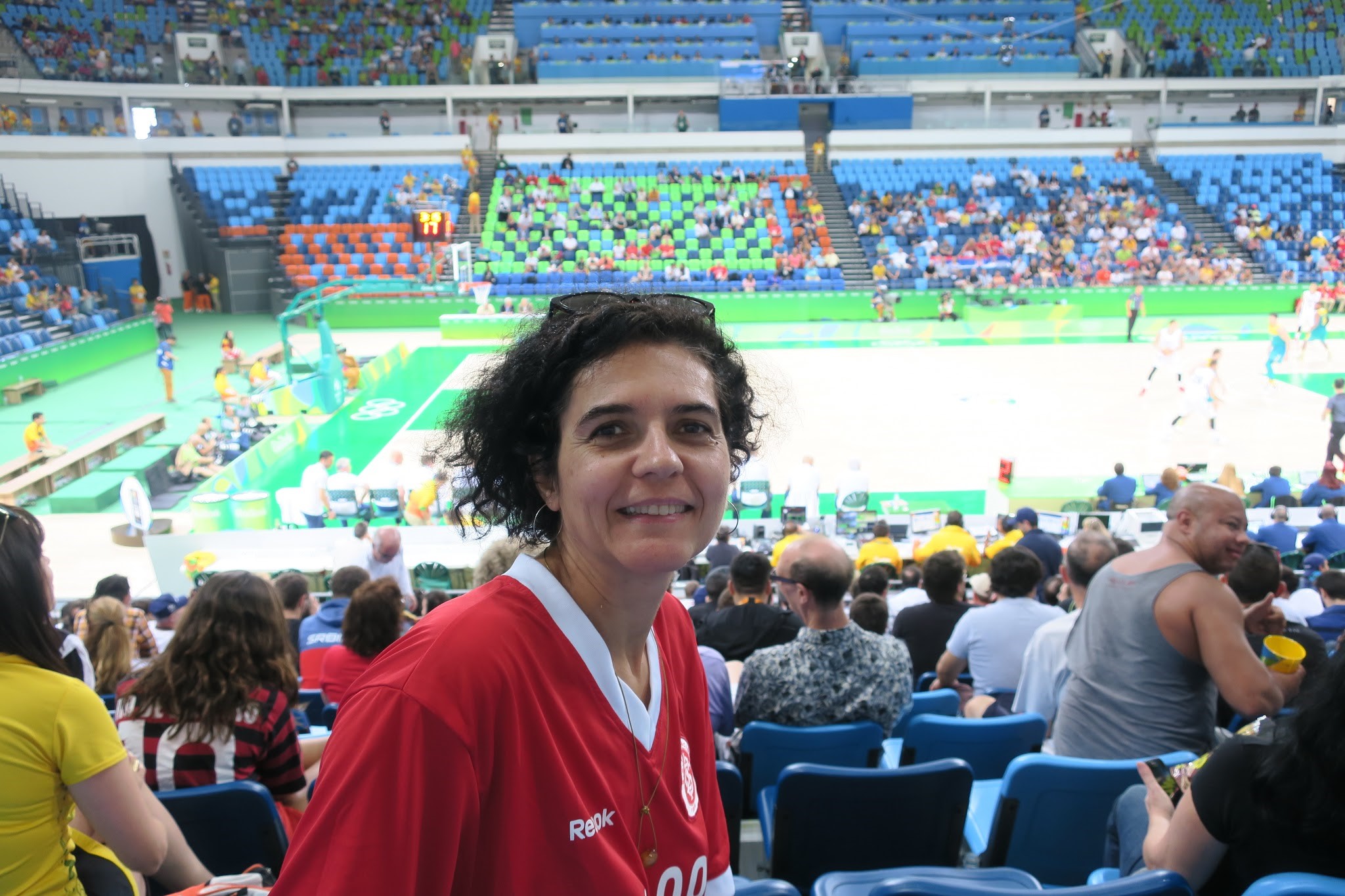
Lecture at the Carioca Center of Design, Rio de Janeiro, August 2016
Jilly Traganou is an architect and Associate Professor in Spatial Design Studies. Her recent publications include a book titled Designing the Olympics: Representation, Participation, Contestation (Routledge, 2016). She is the author of The Tokaido Road: Traveling and Representation in Edo and Meiji Japan (RoutledgeCurzon, 2004), a co-editor with Miodrag Mitrasinovic of Travel, Space, Architecture (Ashgate, 2009) and a contributor to several books, most recently the Routledge Companion to Design Studies (2016). Professor Traganou has been Fellow of the Japan Foundation, the European Union Science and Technology postdoctoral program, Princeton Program in Hellenic Studies, and Bard Graduate Center, as well as a recipient of two Graham Foundation grants. She has most recently been the recipient of a Fulbright Scholarship and spent last summer in Rio de Janeiro conducting design research on the last Olympic Games.
Congratulations on your Fulbright Scholarship! I’d like to explore the relationships you find between design, national identity, and citizenship through the categorical range of Representation, Participation, and Contestation. In any order, what has been your experience with each?
When I first started working on this subject, my interest was how national identity was being represented through the design of Olympic artefacts. For example, if we look at the Olympic emblems, we can observe aspects of the international symbolism of the Olympics, through the presence of the rings for instance. At the same time, according to the Olympic protocol, the host city has to portray its own identity. And sometimes it’s re-branding itself to separate from the past and to create a new image for the future. My interest in representation emerged in Greece, where I come from. The 2004 Olympics happened in Athens, and I went back to Athens in 2003 to study the multiple notions of Greek identity being represented through the architecture for the Olympics.
Regarding participation, an important question to ask is: Who is creating the Olympics or deciding what this new identity is, and how can it be expressed through design? Of course we know that the Olympics is a very exclusive operation. There’s a very top-down approach to design with appointed designers, or an occasional contest winner. But there are certain attempts or moments of including other voices. The most common place to find these other voices is in the realm of interpretation of these forms——how people try to understand them, appropriate them, or even create new meanings or forms out of them. The meaning of a design is not always obvious. The variety of meanings that are expressed in the public realm both visually and verbally provides the first cracking of the box of the Olympic organizers being in control of the game. In more recent years there have been some attempts to approach Olympic design as a participatory field to be created to some degree by the public, not only by those exclusively appointed designers.
Contestation, the third part of the book, is the act of questioning and resisting the Olympics. It manifests where people produce new design forms in interaction with, or in opposition to the Olympics, e.g., creating design forms and processes to question who the Olympics are for, expressing their disagreement or empowering communities that have been disenfranchised by Olympic development.
Could you talk about the case studies featured in your book?
In the order of my own history, I researched the Olympics that took place in Athens in 2004, in Tokyo in 1964, and in London in 2012. Also, the book features a chapter on dissent, which looks at how different counter-Olympic movements in different cities have used design. Sometimes not openly confrontational, but more to the point of asking questions or creating space for recuperation.
Are you more interested in how the Olympics affects a place or how the place affects the Olympics? Or do both factor equally?
I’m curious what it would mean to look at how a particular place—a host city—affects the future of the Olympics. So there are some disappointing patterns that are being repeated with each Olympic year. And the designers are possibly accepting the Olympic objective of overachievement, so there is this idea of breaking the record each time with the design, e.g., of a more high-tech or a bigger stadium. I would’ve liked to see a different model in Rio of an Olympic city that would leave a different legacy to the Olympic institution, for an Olympic city that is inclusive, sustainable, equitable and that addresses the issues of poverty that we see in a mega-city like Rio.

Lecture at the Carioca Center of Design, Rio de Janeiro, August 2016
While in residence as a Fulbright Scholar in Rio de Janeiro, what were some of the conversations you had about the intersections between design, politics, and the history of the Olympics?
I gave a presentation at the Federal University in Rio about chapters in my book where I discuss the role of Olympic architecture for Athens. I also participated in a few more conversations at The Architecture and Urbanism College of the University of São Paulo, and then returned to Rio to have a conversation in The Carioca Center of Design. I also participated in the Olympics studies conference in Vitoria.
There was a lot of attention on Rio this summer for many reasons. The political situation was a big one and was the focus of most citizens, including those who attended the Olympics. We saw many people protesting inside the stadiums against Temer, the President who replaced Dilma Rousseff. Also many people from around the world traveled to Rio to celebrate or study the Olympics from different cultural perspectives. Intellectuals and activists (such as members of Amnesty International) observed the effects of the Olympics on the city and particularly on the favelas, the resistance to the Olympics, as well as organized new actions. The mainstream media of course ignored many of the demonstrations, one of which took place on the opening day very close to the stadium.
Do you think the media exaggerated the polluted conditions of the water in Guanabara Bay?
Even though we haven’t heard of anything particularly dramatic happening to the health of the athletes as a result of the pollution in the water, it is true that this Olympic site was not cleaned. This was a missed opportunity for the city. First of all, it may have been a really exaggerated promise to the Olympic community and to the world that Guanabara Bay would be cleaned. It was of course extremely difficult to clean, for many reasons, but if the Olympic authorities and the city had focused on having some sort of social impact by, for instance, providing sewage facilities to the favelas that are neighboring the river that is connected to Guanabara Bay, then maybe they could’ve created a very positive example of the role the Olympics could play in a city’s evolution. And future Olympic cities could use this as a model. But Rio invested the money elsewhere, following the public-private partnership model that is based on speculative urban transformation that favors the city’s elites.
It was a very extravagant opening ceremony.
Still it was less expensive than previous ceremonies, which indicates a progressive effort. But the city’s and the Olympic organizers’ priorities obviously didn’t include helping the people who live in the favelas, even though the favelas were a main feature of the ceremony.

Rocinha, a favela in Rio de Janeiro, July 2016
Do the Olympics ever positively affect an environment?
(laughter rises between us and quickly falls)
Because of the extreme poverty and the informality of a large part of Rio, it was a very unique city in the history of the Olympics. But perhaps you could compare it to Tokyo in 1964, which was very different in late 60s from what it is today. They didn’t have a proper sewer system, and they didn’t have the transportation system they have now. So they had to implement big infrastructure works as part of their Olympic program. In order to do that, they also cleared many of the slums Tokyo had back then. Historically, some of the issues with Rio repeated similar approaches of Tokyo 1964 or Seoul 1988, in terms of the large scale urban transformations, the way the poor were treated, and the gentrification brought by the Olympics to certain parts of the city as “development” or rezoning.
It seems the host cities are checking off a list of requirements.
Yes, but the questions to ask are: Should the Olympics be so big? Should they operate the same as they have since the ’60s? Should they be about complete urban transformation or should they be a smaller event that doesn’t need everything to be state-of-the-art? Perhaps the Olympics would not need to completely change the infrastructure of the city. This accelerates development and urban transformation but without a democratic process. And because there is always a deadline (the Opening date of the Olympic Games), then everything happens in a hurry, and in a state of exception, with a very small degree of participation. And the results benefit those who sponsor the Olympics—the elites of the city who want to steer the city development in their own direction, and the private sector, especially those related with construction and real estate businesses. But it doesn’t have to be this way. The Olympics could be downsized, or decentralized. The Olympic city could move towards the direction of more inclusionary urban transformation. There have been many suggestions by activists and scholars for improving both the process and the results. None of these proposals are truly of interest to the Olympic committee, though.

Can you unpack some of the examples of identity from your book and share how they affect your perception of the national identity of the Olympics?
I was in Athens and witnessed the city under construction for the Olympics. It was interesting to observe the effects this process had on the identity of the people, who were also changing; it’s not just the city under transformation. The people are trying to understand what this Olympic thing means, while they are changed through both the process of inquiry and the intentional transformation that the Olympics bring. I did a lot of studies of how the media and citizens of Athens talked about and tried to make sense of what the nation was doing through the Olympics and what it meant to them. There was a lot of hope and anticipation for a positive change that the Olympics would bring, and thus there was very little contestation of the Olympic project per se. But there was a lot of disagreement on what the nation should become through and after the Olympics. There were multiple contested opinions that partly had to do with a re-interpretation of the past which is very important for Greece, and a main resource for the design and visual languages of the Olympics.
What were some of your research methodologies?
Greece and Brazil were the Olympics I really experienced in an empirical way by actually being there for extensive period of time. The other cities I wrote about involved a different type of research. For Tokyo I did a lot of archival research because it was in the past. I visited London numerous times during the Olympic preparations and saw the Olympic Park and the surrounding areas as they were developing during the construction process. I also looked at reports in the media, as in several other chapters. I also had a lot of interviews with designers, residents, and people who belonged to political organizations for both my London chapter and the chapter on dissent.
Has the honor of receiving a Fulbright Scholarship affected your perception of the honor itself?
Whenever a student or a scholar receives an award like the Fulbright, it is transformative. I received a similar scholarship from the Japanese government when I had just graduated from the university in Greece. I was 26. It was the most transformative experience of my life, and allowed me to conduct funded research in Japan for a year and a half. Beyond the honor, it was really about the exposure that the generous scholarship allowed. Interacting with people from many other countries in a new place, and discussing concepts, completely changed how I saw myself and my future. At this point in my career and life, receiving the Fulbright award is very welcome, as it affords the comfort of the research abroad and the exchange with other scholars and residents in the city. Two months is very luxurious and allows me to learn about more than just the research subject. Receiving a grant makes it easier to apply and receive the next grant and continue the work. My Fulbright is not over yet, so I will go to Brazil again next year. With Flex, there is a choice to do 3 months continuously, or do 2 months and then 2 months separately. The latter works for me very well because my topic is also looking at the aftereffects of the Olympics on Rio.

Jilly attending a basketball game during the Rio 2016 Olympics
Will the Rio de Janeiro research appear in future books?
Most likely, yes. I’m discussing a book proposal with Routledge about Design and Dissent. I will co-author a chapter about the Olympics in Rio together with colleagues I met and worked with in Rio.
I’m not a Brazil scholar, but having been an area studies scholar on Japan in the earlier years of my career I know how difficult it can be to fully understand and write about a country, especially one that is not one’s own or one’s field of expertise. The language can of course be another problem. You need to have translators, and work with other people. But on the other hand you have to bring so much more knowledge in the research than the subject you’re looking at. I believe that my broader research experience and the approach I have developed in studying the Olympics hopefully compensates for the lack of language knowledge or specific knowledge on Brazil.
How would you describe your approach to Olympic design?
When I look at Olympic design I look for a spectrum of projects, a broader design milieu, starting from the official products by those who are authorized to design for the Olympics (stadiums, emblems, etc.), and ending with designs that are generated by non-official Olympic actors, such as people who protest in the streets or artists who work with communities that are displaced due to the urban transformation that the Olympics brought to their city. And these last examples are no less powerful or evocative than the first, and hopefully we will see their impact in the ways they help communities become more resilient and resistant to the negative effects of urbanization. Also what I have observed is that the Olympics are often accelerators of processes that cities are undergoing today, and architecture often acts as a smokescreen to distract from pervasive changes such as rezoning or changes to the masterplan justified by the state of exception that the Olympic city finds itself in. We see these patterns over and over again. In the Olympics they are even more concentrated and intense.
